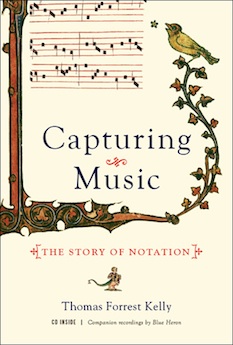By Katy Sternberger
For anyone interested in medieval history, music, or language and communication, Capturing Music: The Story of Notation is a fascinating study written by Thomas Forrest Kelly, a professor of music at Harvard University. From early ideas about writing as recording to Guido the monk’s “brilliant new technological solution,” which inspired our current thinking on music and how we write it down, there is a lot to absorb in this book, but Kelly makes it approachable.
Whether you wish to learn about the technical aspects of reading medieval music or you are interested simply in how music came to be what it is today, this is a well-researched and engaging history. The point of Kelly’s book is not to teach you how to read medieval musical notation, but if you want to delve further into the mechanics of it, he provides more detail in boxed-off sections called “A Closer Look.” He teaches you the vocabulary of medieval musical notation and uses numerous excerpts from manuscripts as examples.
Filled with reproductions of colorful, gilded miniatures and notated pages, Capturing Music itself looks like an illuminated manuscript. It includes a CD, recorded by the Blue Heron ensemble of Cambridge, Massachusetts, containing 17 tracks that demonstrate how music progressed through the Middle Ages. In addition to the manuscript pages featured throughout the book, an appendix provides the text and translations for each of the recordings.
Kelly explains that much of what we know about medieval music is necessarily based on religious music because scribes and clergy were the few people who knew how to read and write. Sound was an integral part of elaborate church ceremonies and gave the audience cues about certain parts of the service. However, early medieval music, consisting mostly of chants, was written down such that the singer needed to memorize the melody. The ability to perform a song depended upon how one note was sung relative to the next—there was not yet a system for writing what the notes were or how long they were. Signs, called neumes, were scrawled above each syllable of the text to indicate how it was to be sung. Indeed, “writing the words of a song is in itself a kind of musical notation,” Kelly says.
All kinds of neumes were developed to specify the performance of a song, and it was important to sing the melody correctly because it was for the glory of God. Kelly says, “These notations, we need to remember, were devised for people in churches and monasteries whose job it was to sing the chant every day for the rest of their lives. And they were not singing for others: there was no audience but God, but that was reason enough to get it right.”
It was Guido the monk in the eleventh century who set down the pitches of notes by drawing parallel lines to create a grid—what we know as the music staff—and he gave notes the names we memorize today: “ut, re, mi, fa, sol, la.” He used the first syllable from each line of a hymn about St. John the Baptist, called “Ut queant laxis,” as a mnemonic device to help students remember the notes (changing “ut” to “do” and adding a seventh note, “ti,” were later developments). The notation Guido created was “prescriptive,” according to Kelly. You no longer needed neumes to help recall what you had already memorized—he prescribed a way to sing what you had never heard before.
Guido’s system was not without its problems, including the “loss of performance nuance” that neumes had provided, but he enabled future improvements in musical notation. For example, Leonius, an official from the Cathedral of Notre-Dame in Paris, developed a way to notate rhythm, or the length that a note is sustained. Later, Franco of Cologne figured out how the shape of notes could indicate their length, and he devised marks to denote pauses in the music. Nevertheless Guido’s basic principles have not changed for centuries.
In fact, Kelly brings his discussion of medieval music straight into the present by addressing current technological advancements that allow us to record and reproduce music, something we tend to take for granted. Without the development of musical notation in the medieval era, we would not understand what medieval music sounded like; we would not be able to duplicate music so that it transcends time.
Katy Sternberger (ΦBK, University of New Hampshire, 2012) is a writer, editor, and researcher. After graduating from the English/journalism program at the University of New Hampshire, she is now pursuing her master’s degree in archives management at Simmons College.




